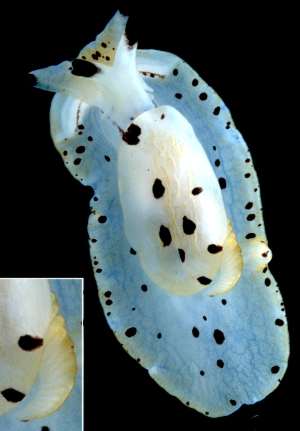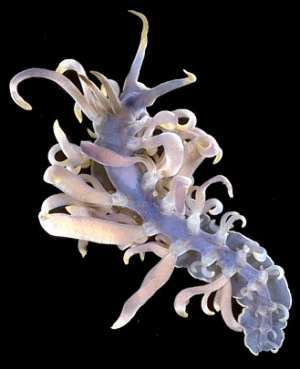

Autotomy
PHOTO
UPPER: Berthella martensi, showing the loss of all the mantle skirt. Note gill [inset] on right side now exposed by loss of mantle skirt. Usually none of the foot is visible. Coffs Harbour Region, New South Wales, December 1990.
LOWER: Phyllodesmium magnum showing the loss of many of the cerata. Koumac, New Caledonia, October, 1993. Photos: Bill Rudman.
Most of us are familiar with the way many lizards, especially skinks, can drop their tails when disturbed. The tail remains wriggling and writhing for some time, distracting predators and allowing the lizard to escape to grow a new tail.
This process of casting parts of ones body is known as AUTOTOMY. Although sea slugs are unable to escape as fast as lizards there are a number of spceies which have evolved the ability to drop parts of their body as a means of defence. One common example is the large tropical dorid Discodoris lilacina which often casts the whole of its mantle skirt when handled. One of its other names, Discodoris fragilis reflects this behaviour. For further examples, search for autotomy on the Forum's Search page.
Illustrated here is the pleurobranch, Berthella martensi which does the same thing. It has a number of colour forms, but in almost all of them their is a brown ring around the mantle which marks the fracture point along which the mantle breaks off.
The second example here is of a species of the aeolid genus Phyllodesmium. Most aeolids defend themselves with nematocysts from their cnidarian food which are stored in cnidosacs. Species of Phyllodesmium however, feed on octocorals whose nematocysts are not very useful defensively. It is no coincidence that most soft corals possess are range of distasteful and poisonous chemicals which they use to protect themselves from predation. Because Phyllodesmium are unable to utilise the soft corals nematocysts for defence they have also developed an alternative strategy. At the tip of each ceras the cnidosac has been replaced by a large gland which produces a copious sticky secretion. When the animal is attacked it is able to drop of numbers of its cerata which become sticky from the secretions, and wriggle around. Presumably these discarded cerata distract predators sufficiently to allow the aeolid to escape.
Not much is known about regrowth of body parts. There is a study by Bickell-Page (1989) on ceratal autotomy in Melibe leonina, which investigates the complex processes in both the nervous system and the muscles, which is needed for autotomy to occur. But there is no mention of regrowth. However there is a paper on ceratal loss in the aeolid Hermissenda crassicornis (see Miller & Byrne, 2000) which showed that Hermissenda can fully regrow its cerata in about 40 days. An earlier study by Kress (1968) on a number of species of Doto, showed it took between 30 and 60 days for full regrowth depending on the species.
-
Bickell-Page, L. R. (1989) Autotomy of cerata by the nudibranch Melibe leonina (Mollusca): ultrastructure of the autotomy plane and neural plane and neural correlate of the behaviour. Philosophical Transactions of the Royal Society of London, B, 324: 149-172.
-
Kress, A. (1968) Untersuchungen zur histologie, autotomie und regeneration dreier Doto-Arten Doto coronata, D. pinnatifida, D. fragilis (Gastropoda, Opisthobranchia). Revue Suisse de Zoologie 75: 235-303.
-
Lewin, R. A. (1970) Toxin secretion and tail autotomy by irritated Oxynoe panamensis (Opisthobranchiata: Sacoglossa). Pacific Science 24: 356-358.
-
Miller, J. A. & Byrne, M. (2000) Ceratal autotomy and regeneration in the aeolid nudibranch Phidiana crassicornis and the role of predators. Invertebrate Biology, 119: 167-176.
-
Piel, W. H. (1991) Pycnogonid predation on nudibranchs and ceratal autotomy. The Veliger, 34: 366-367.
Rudman, W.B., 1998 (October 14) Autotomy. [In] Sea Slug Forum. Australian Museum, Sydney. Available from http://www.seaslugforum.net/find/defauto
Related messages
Self mutilation in sea slugs
January 20, 2003
From: V. Patel
Dear Bill,
Sea slugs are considered to the most remarkable example of self mutilation and I would be very grateful if you could recommend any usuful literature.
Thankyou
V. Patel
v.patel@newman.ac.uk
Dear V. Patel,
'Self-mutilation' is a peculiarly human activity. By definition it requires a knowledge of 'self' and is a prpduct of a very troubled mind. Many animals however, have evolved the ability to drop or break off parts of their body, but as their bodies are designed to do this, I hardly think we should call it 'mutilation'. I remember many years ago there was a controversy in New Zealand about whether it was cruel to cut the tails off living crayfish [lobsters]. The Minister of Fisheries got up in Parliament and said we, and presumably the lobsters, had nothing to worry about, as his experts had told him that joint-legged animals like crayfish had evolved to drop off limbs like this in a process called autonomy and it didn't hurt them a bit!
The process is called autotomy, not autonomy, and although the lizard's tail is an example of it, the poor lobster's tail is not. Have a look at the autotomy page on the Forum for some opisthobranch examples. Not all peculiarities in body shape are the result of autotomy. Have a look at the Abnormalities page for a growing list of strange abnormalities caused by accidental damage or developmental problems.
Best wishes,
Bill Rudman
